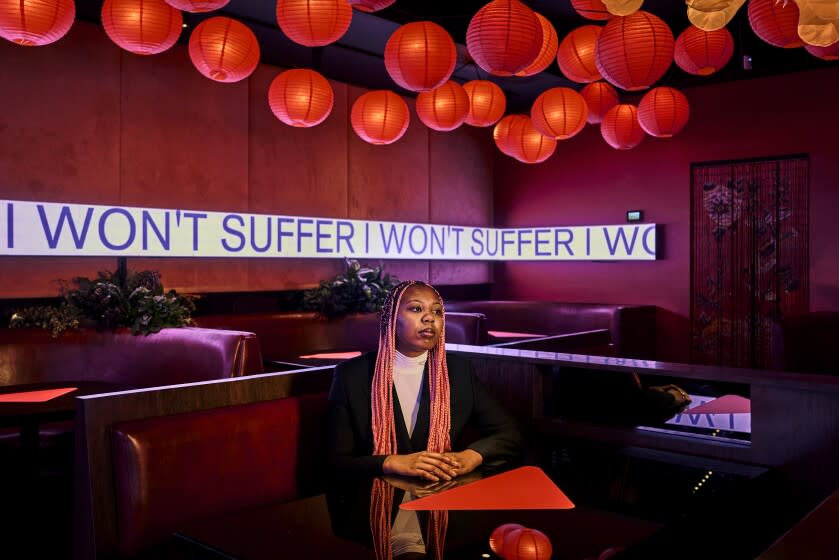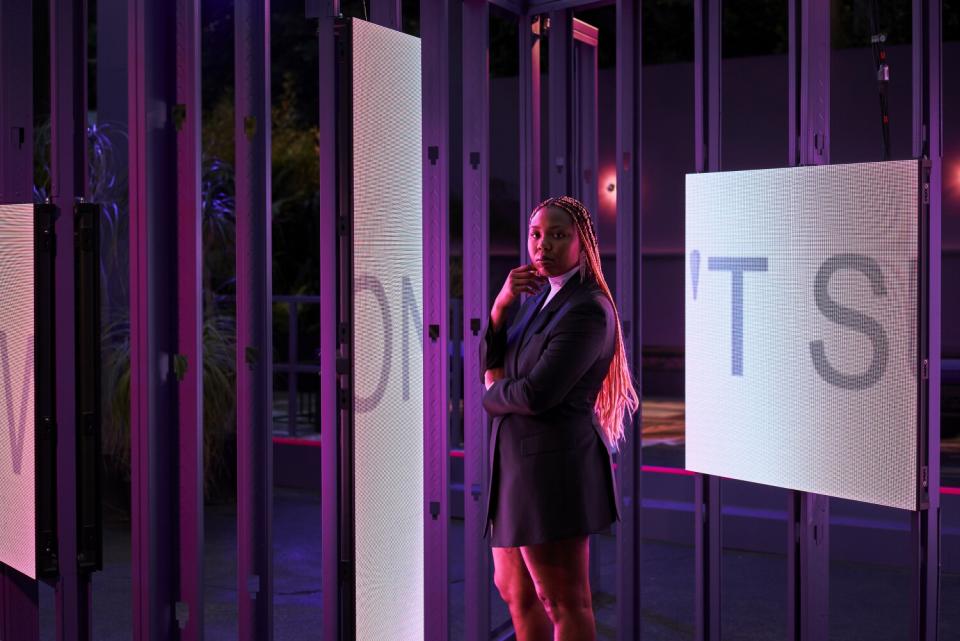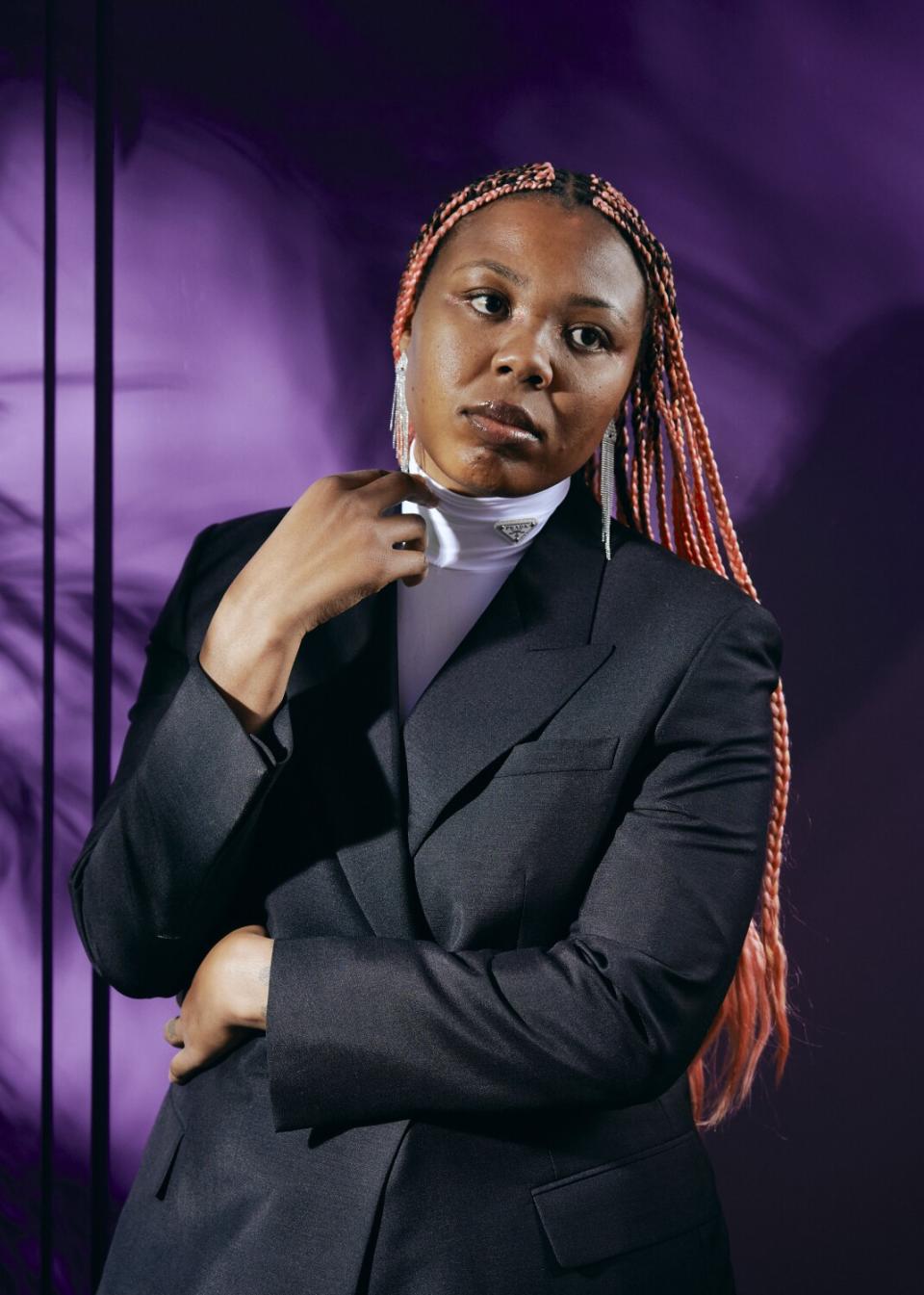What does it mean to be truly alive in L.A.? Martine Syms is using film to figure out

- Oops!Something went wrong.Please try again later.
This story is part of Image issue 9, “Function” a sonic and visual reminder that there ain't no party like an L.A. party. Read the full issue here.
Martine Syms is a conductor of a “Black spatial imaginary.” A choreographer of community, mutuality and democratic imaginations, Syms encapsulates this synergy of Black geographical matters in her use of screens and their ability to figure space. For Syms, screens have been outfitted as directorial tools for her feature and shorter-length films; focusing on the gestures and movements of Black women/femmes within their own bodies (“Notes on Gesture”), as traveling throughout the U.S. (“Incense Sweaters and Ice”), and within a digital scape (“Black Box”). In her latest feature, “The African Desperate,” Syms lands us in 2017, on the last day of an MFA program for the film’s protagonist Palace Bryant (played by Diamond Stingily). Here, the screen journeys us with Palace as they move through the predominately white institution's (PWI) campus, faculty critiques and many parties. The lone Black woman, Syms captures the humor-filled pleasure and horror scape of art school.
Screens are also foundational to Syms’ most recent installation “HelLA World,” a two-day-long event that took over the local L.A. haunt Genghis Cohen on Fairfax and Melrose. Presented via Prada Mode, the traveling social club during Frieze L.A. was reimagined by Syms as a kosher Chinese food restaurant turned multisensory social site. Panel discussions, DJs, dinners and an array of CCTV screens and digital banners swelled crowds of guests toward each other in a sea of purple. Screens hosted strangers with each other, forwarded DM conversations into a public scrawl and response, and projected excerpts from Sam Cooke’s 1963 performance at the Harlem Square Club in Miami. With “HelLA World,” Syms continued her discursive attention to placemaking, threading together people, food, music and conversations across time in her visionary architectural wonderland in central Los Angeles.
On the occasion of the premiere of “The African Desperate” and “HelLA World,” Syms and I chatted in her studio in Leimert Park.
Essence Harden: There's this quality in your work that presumes a borderless expanse; the way the mediums, pathways and narrative devices are tools freed from a fugitive state. In part, this feels related to your own educational background, home life and navigation of space. Can you speak more directly to the way that education, in particular punk ethics and home-schooling, grounded your practice? And if this sense of DIY ethics speaks to your practice?
Martine Syms: This quality is more pronounced to others. It’s simply the air I breathe. Everything has always been connected to me. Perhaps it comes from growing up in church, home-schooling, being a punk, with community activist union member parents. I don’t know. In my experience, if you want something done you do it. [It’s] more fun to “do it” with others. I love learning. I love searching for a form for my ideas. That energy propels me. It’s how I touch the world. This is what has drawn me to publishing. I don’t feel satisfied unless my ideas are public, and in turn, that there is a public around my ideas.
EH: I love the way that in your work collaboration is a principal. It shows up endlessly with you. And I love that you establish a relationship with the people you've worked with. It's quite profound to do that in a public setting. It's really beautiful.

MS: My art making has always been really supported by community, whether that was bands I was in growing up, my peers or my scene. The Echo Park film stream was one of the places I first took film. I had gone to CalArts' pre-college program. One of my teachers taught at Echo Park Film Center. So I started to go there — I was a “student” but I also taught workshops, worked the co-op and organized screenings.
So many of my favorite experiences in my life have been with my friends. I'm always, literally, calling somebody. Diamond Stingily is a good friend of mine who plays Palace in the movie. One of my closest friends. We've collaborated before, she's been in other works of mine. We have running jokes, stories that we tell each other. Sometimes we have these long phone calls that we call our podcast — it's just us talking. Just being aunties. It's part of what's just so nice about our friendship. Aside from her, Liam, who's in the movie, is one of my best friends. Brent Freaney did all the design, all the titles and all the costumes. Everybody has like three credits. Natalie was post-producer and did music supervision. There [are] things I like to do on my own, but, sometimes you need help. Sometimes you need other people. I just love working with brilliant people and spending time with [them] because that's most of it — the making, the process. Shooting was psychotic, let me be clear. We fully opened up another dimension to get everything done. But we were also all dancing and having fun.
EH: In a recent interview, you said, “Black people own the internet.” I know this to be the truth; there’s also a confounding relationship in this afterlife of slavery existence wherein ownership is a slippery slope for Black people. Could you talk more about how you explore Black cultural productions as a technology and what this notion of dis/possession has looked like as you investigate it within your own practice?
MS: I spoke about this at length in 2013 at a SXSW talk called "Black Vernacular." My artwork is often focused on Black Americans, but I’ve found this to be true across different cultures: Black speech is a hypertext language. The building block of the internet is a referential, signifying, mimetic, poetics. Think about drum machines! We have a long tradition of FREEQing technology.
Lil Nas X is a patron saint of the form. Never forget he used to run a Barb meme account! I’ve made a few artworks — a drawing, a series remaking of his TikToks — over the past few years that invoke him.
Some are hopeful that crypto, NFTs, DAOs are the beginning of addressing the wealth disparity between the “creators” and tech overseers. I have my doubts. I’m still salty I pay for Adobe Creative Suite now. I had a cracked copy for years.
I like noise. I need distortion. Gimme artifacts. I love a low hum. In practice, my studio looks like an eBay store with cameras, monitors, scanners, mics, samplers, pedals and cables everywhere.
EH: Your short-form and long-form films are these black geographical surveys, covering the movement of bodies onto themselves and throughout space. Can you say a bit more about the subject of place within your work and the narrator of choice often being Black women/femmes?
MS: I work with moving images because it allows me to bend spacetime. The transatlantic slave trade(s) and the great migration still influence my daily life. In his essay, “Notes on Gesture,” [Giorgio] Agamben points to cinema as the container for the movements, gestures we lost while gaining modernity.
I made a video in 2015 of the same name where artist Diamond Stingily performs Black femininity. I also made a performance that year called “Misdirected Kiss” that starts with a found image of a young, Black girl a visitor mistook for me and ends with a story of my family telling me not to go on a solo road trip around the time of Sandra Bland’s death.
I’m a Black woman and my life is inextricably tied up with those who look like me. One of my animating questions is how the body is a site of struggle and how that struggle evolves as the body itself shape-shifts from flesh and blood to vaporous ghost or unattainable data set.
I have to be repeatedly thrown against death-ness to be alive. Whatever happens to a s—y JPEG or GIF has consequences on my body. It’s called compression. The image is now part of our flesh.

EH: You talked some about “social choreography” in relationship to cameras and surveillance and I wondered if you could speak more directly to your desires as a director with film and with “HelLA World,” in particular?
MS: My films are about the way routine experiences of spectacular and mundane violence create insanity and despair. Where humor kisses pain. How s— happens and then you live, because I’m curious how people continue to find a way.
I use film to figure out what it means to be alive. What does it mean to be an unruly, breathing, s—ing, f—ing, fleshy thing in a world full of screens? Over the past few years, I work from the assumption that anything that happens when someone is watching is a performance.
In my installations, such as “HelLA World,” the cinema is ambient and ever-present. It’s made in collaboration with me and the audience. I build the “story” around how we socialize and behave in public. I know the story of a party (quite well!) and I wanted to use both text and image to tell it.
In my films I get to be more specific, more ambitious, more thoughtful, more rigorous. "The African Desperate" is also about a party. I get to focus on the stranger, funnier, confusing and disappointing parts.
I built the world with my co-writer Rocket Caleshu, and later on set with my DP Daisy Zhou and star Diamond Stingily. We could stretch out one moment and skip over another. We could linger in an awkward parting or make a meal out of a toast.
I could’ve done that at Genghis Cohen too but I would’ve been stuck in the A/V closet and I wanted to party.
EH: I love L.A. sites and how architecture is a fluid enterprise here. Why Genghis Cohen and why “HelLa World” for the title?
MS: Genghis Cohen has been a locals-only spot for years. It’s Kosher HK-Style (not N.Y. style!) Chinese. I lived nearby for years and had a standing Sunday dinner there with some friends, a hangover from an ex’s family tradition. I’ve gone to some fun parties there and when I was a young buck they didn’t card. Plus, you could sneak through the kitchen. It’s L.A., baby.
Everything becomes funnier when you just remind yourself you’re in Hell. Traffic is Hell. Late summer heat is Hell. No-sun, fire-season Hell. Being stuck at a party of boring celebs in the hills somewhere Hell! Trying to find parking in Ktown HELL! West “Hell”-ywood!!!
Los Angeles is a hellscape, but it’s my hellscape. I love it here and I’m never going to leave.
Essence Harden is a visual arts curator at the California African American Museum. @essenceh
More stories from Image
This story originally appeared in Los Angeles Times.

